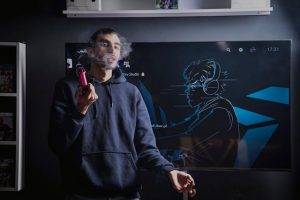The debate over the safety of smoking cigarettes versus vaping has gained significant attention in recent years. Both activities are associated with numerous health risks, yet many people believe that vaping is a safer alternative. This article explores the myths and realities surrounding smoking cigarettes and vaping, focusing on their impacts on health, lungs, teenagers, and the reproductive system of adult individuals.
Comparing Health Impacts: Smoking vs. Vaping
The Perception of Safety
Smoking cigarettes has long been known to cause severe health problems, including cancer, heart disease, and respiratory issues. Vaping, on the other hand, is often perceived as a safer alternative due to the absence of tar and many harmful chemicals found in cigarettes. However, this perception does not fully account for the potential risks associated with vaping.
Chemical Composition and Exposure
Cigarettes contain thousands of chemicals, including over 70 known carcinogens. In contrast, e-cigarettes contain a liquid that is vaporized and inhaled. This liquid typically includes nicotine, propylene glycol, glycerin, flavorings, and other additives. While vaping reduces exposure to some harmful chemicals found in cigarettes, it introduces other potentially harmful substances.
Impact on the Lungs
Short-Term Lung Effects
Both smoking and vaping can cause immediate irritation to the lungs. Cigarette smoke contains numerous irritants and toxins that can lead to coughing, wheezing, and shortness of breath. Similarly, the aerosol produced by vaping can irritate the airways and lungs, leading to symptoms such as coughing and wheezing, commonly referred to as “vaper’s cough.”
Long-Term Lung Health
The long-term effects of smoking on lung health are well-documented, with smoking being a leading cause of chronic obstructive pulmonary disease (COPD) and lung cancer. Vaping is still relatively new, and while it appears to cause less immediate damage than smoking, there is growing evidence that it can lead to chronic lung conditions and severe lung injuries, such as “popcorn lung,” caused by inhaling certain flavoring chemicals.
Teenagers and Vaping: A Growing Epidemic
Rising Popularity Among Teenagers
Vaping has become increasingly popular among teenagers, partly due to targeted marketing and appealing flavors. According to the Centers for Disease Control and Prevention (CDC), e-cigarette use among middle and high school students has surged in recent years. This trend is alarming given the potential health risks associated with vaping.
Health Risks for Teenagers
Nicotine exposure during adolescence can have long-lasting effects on brain development, leading to cognitive and behavioral issues. Teenagers who vape are also more likely to start smoking traditional cigarettes, increasing their risk of addiction and long-term health problems. Both smoking and vaping pose significant health risks to young people, making prevention efforts crucial.
Social and Psychological Impacts
In addition to physical health risks, vaping can have social and psychological effects on teenagers. The addictive nature of nicotine can lead to dependence, affecting academic performance and social interactions. Moreover, the normalization of vaping among peers can create pressure to engage in this risky behavior.
Effects on the Reproductive System of Adults
Male Reproductive Health
Both smoking and vaping can negatively impact male reproductive health. Smoking is known to reduce sperm quality and count, leading to potential fertility issues. Vaping, which exposes users to nicotine and other chemicals, can also harm sperm quality and cause oxidative stress, damaging sperm DNA and affecting reproductive outcomes.
Female Reproductive Health
The negative effects of smoking on female reproductive health are well-documented, including menstrual cycle disruptions and reduced fertility. Vaping, while often perceived as less harmful, can also lead to reproductive issues due to nicotine exposure. Pregnant women who vape or smoke are at risk of complications such as preterm birth, low birth weight, and developmental issues in their offspring.
Long-Term Reproductive Consequences
The long-term consequences of vaping on reproductive health are still being studied, but the potential for lasting damage is significant given the known effects of nicotine and other chemicals. Both smoking and vaping pose risks to reproductive health, underscoring the importance of understanding these dangers.
Dispelling Myths and Understanding Risks
While vaping is often marketed as a safer alternative to smoking, both activities carry substantial health risks. From lung damage to negative impacts on teenagers and reproductive health, the dangers associated with smoking and vaping cannot be ignored. It is crucial for individuals, especially teenagers, to be aware of these risks and for stronger regulations to be implemented to curb the use of both cigarettes and e-cigarettes.
Public health campaigns and educational initiatives are essential to dispel the myths surrounding smoking and vaping and to protect the health of current and future generations. By understanding the true impact of these activities, we can make informed decisions and promote healthier lifestyles.




